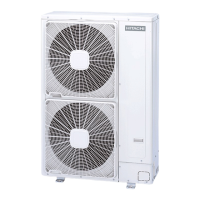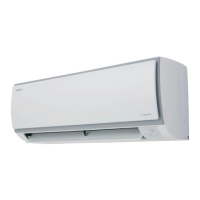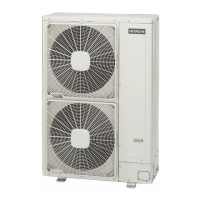6 Vacuum pumping and charge refrigerant
• Vacuum pumping
1. Remove the service port cap of the stop valve on the gas pipe side of
the outdoor unit.
2. Connect the manifold gauge and vacuum pump to the service port of
the stop valve on the gas pipe side of the outdoor unit.
3. Runthevacuumpump.(Workformorethan15minutes.)
4. Checkthevacuumwiththegaugemanifoldvalve,thenclosethegauge
manifold valve and stop the vacuum pump.
5. Leaveitasisforoneortwominutes.Makesurethatthepointerof
themanifoldgaugeremainsinthesameposition.Conrmthatthe
pressuregaugeshows-0.101MPa(or-760mmHg).
6. Removethemanifoldgaugequicklyfromtheserviceportofthestop
valve.
7. After refrigerant pipes are connected and evacuated, fully open all stop
valves on both sides of gas pipe and liquid pipe.
8. Open adjusted valve to add refrigerant.
9. Tighten the cap to the service port.
10.Retighten the cap.
11. Leaktestfoamwithhalogenleakdetectortocheckthearenutand
brazingleaks.Usefoamthatdoesnotgenerateammonia(NH
3
)inthe
reaction.
Fig.9.2
Indoor unit
Pressure gauge
Outdoor unit
Manifold
valve
Charge hose
(forR32)
Vacuum pump
CAUTION
An excess or a shortage of refrigerant is the main cause of trouble to the unit. Charge the correct quantity of refrigerant according
to the description in the manual.
Checkrefrigerantleakageindetail.Ifalargerefrigerantleakageoccurs,itwillcausedifcultyinbreathingorharmfulgaseswill
occurifareisbeingusedintheroom.
• Additional refrigerant charge
Theunithasbeenlledwithrefrigerant.
Pleasecalculateadditionalchargeaccordingto“PipingRequirement”.
Afternishingvacuumpumpprocedures,rstexhaustairfromcharge
hose, then open valves, charge refrigerant through liquid stop valve.
At the end, please close valves and record the refrigerant charge
quantity.
Thisproductcontainsuorinatedgreenhousegasescoveredbythe
Kyoto Protocol.
Do not vent gases into the atmosphere.
Pleasellintherefrigerantchargelabelthatadheredintheproximityof
theproductchargingportwithindelibleink.
tCO
2
:
R3 2
675
kg:
kg:
Containsuorinatedgreenhousegases.
Refrigerant
(A)GWP
Additional charge
(B)Totalcharge
tCO
2
=(A)x(B)/1000
INSTALLATIONINSTRUCTIONS
HO2019292HA
15
EN

